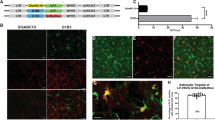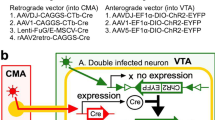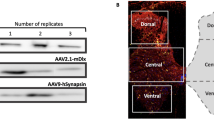Abstract
Lentiviral vectors are promising tools for CNS gene transfer since they efficiently transduce the cells of the nervous system in vivo. In this study, we have investigated the transduction efficiency of lentiviral vectors pseudotyped with Ross River virus glycoprotein (RRV-G) (RRV-G-pseudotyped lentiviral vectors (RRV-LV)). The RRV is an alphavirus with an extremely broad host range, including the cells of the central nervous system. Previous studies have shown that lentiviral vectors can be efficiently pseudotyped with this envelope protein and have demonstrated promising features of such vectors, including the possibility to establish stable producer cell lines. After injection of RRV-LV expressing green fluorescent protein into different structures in the rat brain we found efficient transduction of both neurons and glial cells. By using two cell-type-specific promoters, neuron-specific enolase and human glial fibrillary acidic protein, we demonstrated cell-specific transgene expression in the desired cell type. Ross River virus glycoprotein-pseudotyped lentiviral vectors also transduced human neural progenitor cells in vitro, showing that receptors for the RRV-G are present on human neural cells.
This is a preview of subscription content, access via your institution
Access options
Subscribe to this journal
Receive 12 print issues and online access
$259.00 per year
only $21.58 per issue
Buy this article
- Purchase on Springer Link
- Instant access to full article PDF
Prices may be subject to local taxes which are calculated during checkout





Similar content being viewed by others
References
Deglon N, Hantraye P . Viral vectors as tools to model and treat neurodegenerative disorders. J Gene Med 2005; 7: 530–539.
Kordower JH, Emborg ME, Bloch J, Ma SY, Chu Y, Leventhal L et al. Neurodegeneration prevented by lentiviral vector delivery of GDNF in primate models of Parkinson's disease. Science 2000; 290: 767–773.
Kordower JH, Bloch J, Ma SY, Chu Y, Palfi S, Roitberg BZ et al. Lentiviral gene transfer to the nonhuman primate brain. Exp Neurol 1999; 160: 1–16.
Blomer U, Naldini L, Kafri T, Trono D, Verma IM, Gage FH . Highly efficient and sustained gene transfer in adult neurons with a lentivirus vector. J Virol 1997; 71: 6641–6649.
Jakobsson J, Ericson C, Jansson M, Bjork E, Lundberg C . Targeted transgene expression in rat brain using lentiviral vectors. J Neurosci Res 2003; 73: 876–885.
Ory DS, Neugeboren BA, Mulligan RC . A stable human-derived packaging cell line for production of high titer retrovirus/vesicular stomatitis virus G pseudotypes. Proc Natl Acad Sci USA 1996; 93: 11400–11406.
Farson D, Witt R, McGuinness R, Dull T, Kelly M, Song J et al. A new-generation stable inducible packaging cell line for lentiviral vectors. Hum Gene Ther 2001; 12: 981–997.
Klages N, Zufferey R, Trono D . A stable system for the high-titer production of multiply attenuated lentiviral vectors. Mol Ther 2000; 2: 170–176.
Strang BL, Takeuchi Y, Relander T, Richter J, Bailey R, Sanders DA et al. Human immunodeficiency virus type 1 vectors with alphavirus envelope glycoproteins produced from stable packaging cells. J Virol 2005; 79: 1765–1771.
Kahl CA, Pollok K, Haneline LS, Cornetta K . Lentiviral vectors pseudotyped with glycoproteins from Ross River and vesicular stomatitis viruses: variable transduction related to cell type and culture conditions. Mol Ther 2005; 11: 470–482.
Kahl CA, Marsh J, Fyffe J, Sanders DA, Cornetta K . Human immunodeficiency virus type 1-derived lentivirus vectors pseudotyped with envelope glycoproteins derived from Ross River virus and Semliki Forest virus. J Virol 2004; 78: 1421–1430.
Kang Y, Stein CS, Heth JA, Sinn PL, Penisten AK, Staber PD et al. In vivo gene transfer using a nonprimate lentiviral vector pseudotyped with Ross River Virus glycoproteins. J Virol 2002; 76: 9378–9388.
Sharkey CM, North CL, Kuhn RJ, Sanders DA . Ross River virus glycoprotein-pseudotyped retroviruses and stable cell lines for their production. J Virol 2001; 75: 2653–2659.
Strauss JH, Strauss EG . The alphaviruses: gene expression, replication, and evolution. Microbiol Rev 1994; 58: 491–562.
Forss-Petter S, Danielson PE, Catsicas S, Battenberg E, Price J, Nerenberg M et al. Transgenic mice expressing beta-galactosidase in mature neurons under neuron-specific enolase promoter control. Neuron 1990; 5: 187–197.
Brenner M, Kisseberth WC, Su Y, Besnard F, Messing A . GFAP promoter directs astrocyte-specific expression in transgenic mice. J Neurosci 1994; 14: 1030–1037.
Rosenblad C, Gronborg M, Hansen C, Blom N, Meyer M, Johansen J et al. In vivo protection of nigral dopamine neurons by lentiviral gene transfer of the novel GDNF-family member neublastin/artemin. Mol Cell Neurosci 2000; 15: 199–214.
Georgievska B, Kirik D, Bjorklund A . Overexpression of glial cell line-derived neurotrophic factor using a lentiviral vector induces time- and dose-dependent downregulation of tyrosine hydroxylase in the intact nigrostriatal dopamine system. J Neurosci 2004; 24: 6437–6445.
Deglon N, Tseng JL, Bensadoun JC, Zurn AD, Arsenijevic Y, Pereira de Almeida L et al. Self-inactivating lentiviral vectors with enhanced transgene expression as potential gene transfer system in Parkinson's disease. Hum Gene Ther 2000; 11: 179–190.
Lo Bianco C, Ridet JL, Schneider BL, Deglon N, Aebischer P . Alpha-synucleinopathy and selective dopaminergic neuron loss in a rat lentiviral-based model of Parkinson's disease. Proc Natl Acad Sci USA 2002; 99: 10813–10818.
Stein CS, Martins I, Davidson BL . The lymphocytic choriomeningitis virus envelope glycoprotein targets lentiviral gene transfer vector to neural progenitors in the murine brain. Mol Ther 2005; 11: 382–389.
Consiglio A, Gritti A, Dolcetta D, Follenzi A, Bordignon C, Gage FH et al. Robust in vivo gene transfer into adult mammalian neural stem cells by lentiviral vectors. Proc Natl Acad Sci USA 2004; 101: 14835–14840.
Doetsch F, Caille I, Lim DA, Garcia-Verdugo JM, Alvarez-Buylla A . Subventricular zone astrocytes are neural stem cells in the adult mammalian brain. Cell 1999; 97: 703–716.
Fricker RA, Carpenter MK, Winkler C, Greco C, Gates MA, Bjorklund A . Site-specific migration and neuronal differentiation of human neural progenitor cells after transplantation in the adult rat brain. J Neurosci 1999; 19: 5990–6005.
Wong LF, Azzouz M, Walmsley LE, Askham Z, Wilkes FJ, Mitrophanous KA et al. Transduction patterns of pseudotyped lentiviral vectors in the nervous system. Mol Ther 2004; 9: 101–111.
Watson DJ, Kobinger GP, Passini MA, Wilson JM, Wolfe JH . Targeted transduction patterns in the mouse brain by lentivirus vectors pseudotyped with VSV, Ebola, Mokola, LCMV, or MuLV envelope proteins. Mol Ther 2002; 5: 528–537.
Geraerts M, Michiels M, Baekelandt V, Debyser Z, Gijsbers R . Upscaling of lentiviral vector production by tangential flow filtration. J Gene Med 2005; 7: 1299–1310.
Zufferey R, Nagy D, Mandel RJ, Naldini L, Trono D . Multiply attenuated lentiviral vector achieves efficient gene delivery in vivo. Nat Biotechnol 1997; 15: 871–875.
Paxinos G, Watson C . The Rat Brain in Stereotaxic Coordinates. Academic Press: San Diego, 1986.
Jensen JB, Bjorklund A, Parmar M . Striatal neuron differentiation from neurosphere-expanded progenitors depends on Gsh2 expression. J Neurosci 2004; 24: 6958–6967.
West MJ, Slomianka L, Gundersen HJ . Unbiased stereological estimation of the total number of neurons in thesubdivisions of the rat hippocampus using the optical fractionator. Anat Rec 1991; 231: 482–497.
Acknowledgements
We would in particular thank David A Sanders for providing the RRV-G envelope. Thanks also to Richard Kuhn for providing the anti-RRV E1 antibody and Didier Trono for providing the lentiviral vector system. Thanks to Bengt Mattsson, Ruben Smith, Anna-Karin Oldén, Ulla Jarl, Birgit Haraldson, Christina Isakson and Anneli Josefsson for technical assistance. This study was supported by the Swedish Research Council, Grant no. 13479.
Author information
Authors and Affiliations
Corresponding author
Rights and permissions
About this article
Cite this article
Jakobsson, J., Nielsen, T., Staflin, K. et al. Efficient transduction of neurons using Ross River glycoprotein-pseudotyped lentiviral vectors. Gene Ther 13, 966–973 (2006). https://doi.org/10.1038/sj.gt.3302701
Received:
Revised:
Accepted:
Published:
Issue Date:
DOI: https://doi.org/10.1038/sj.gt.3302701



